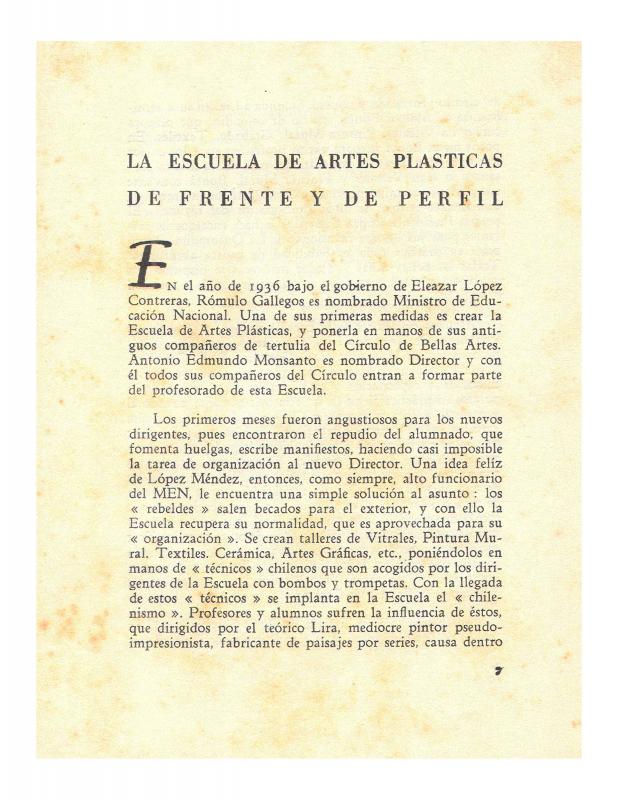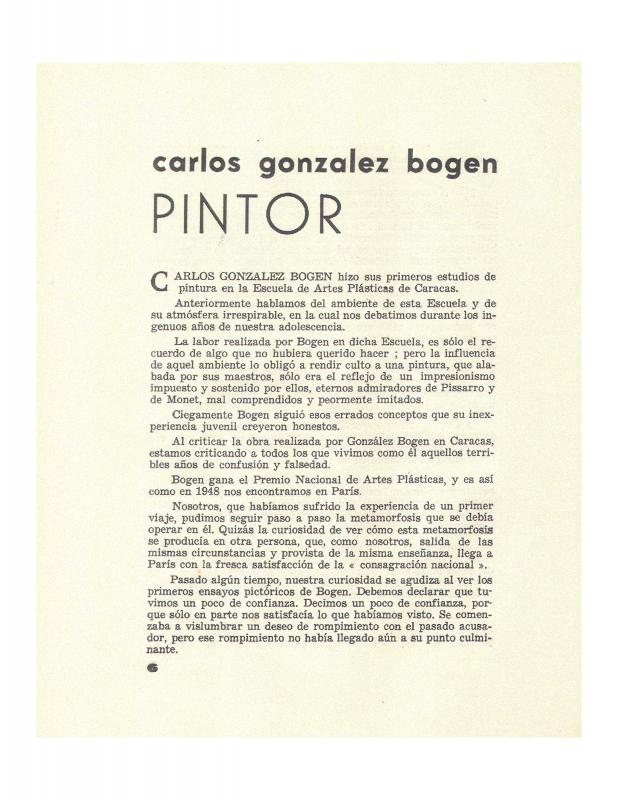Los Disidentes was a group created in Paris in 1950 by a group of Venezuelan artists and writers that lived in the city between 1945 and 1952. From the French capital they intended to fight against the official education taught at the official Escuela de Artes Plásticas de Caracas (EAPCA), derived mainly from landscape art and nativism, specifically. True to their name, Los Disidentes intended to renew traditional and academic art beliefs through the assimilation of European abstract art values. Among the artists in the group was Carlos González Bogen (1920?92), who wrote this text; Alejandro Otero [see doc. no. 813625]; Pascual Navarro; Luis Guevara Moreno; Mateo Manaure [doc. nos. 813569 and 813583]; Narciso Debourg [doc. no. 813597]; Perán Erminy [doc. no. 813463]; Rubén Núñez; Dora Hersen; and Aimée Battistini; in addition to then-philosophy student J. R. Guillent Pérez [doc. no. 813478]. They were joined, subsequently, by other national artists such as Armando Barrios, Miguel Arroyo, Oswaldo Vigas, Omar Carreño, Alirio Oramas and Régulo Pérez. They published a magazine, naming it as the group, Los Disidentes, which produced as far as five numbers, it being the primary source for disseminating their ideas.
This article by artist, sculptor and muralist Carlos González Bogen is a true representation of the group’s dissenting cry: a dialogue that was violent, destructive, and openly accusatory, whilst ridiculing the object of their attacks. While studying art in Paris, the young Venezuelans were proposing a tabula rasa [a clean slate] type of aesthetic revolution with regards to all the established norms within the arts in Venezuela and especially those supported by the official culture. This article from González Bogen is staunchly expressive of the subsequently known as Manifiesto del “No,” the premises in the form of a manifesto found in the No. 5 Editorial of the Los Disidentes magazine.
Los Disidentes strongly criticized all of the policies implemented by the Museo de Bellas Artes, Official Salons, and the Escuela de Artes Plásticas y Aplicadas. Undoubtedly, among those they attacked, the group that most provoked their outrage were the artists in Venezuela that continued operating under the ambivalent title of the “School of Caracas.” Enrique Planchart had coined the moniker in 1912 in reference to the traditional landscape art and nativism produced by the artists active at the Círculo de Bellas Artes in Venezuela’s capital city. The young dissident’s argument in 1950 was that far from representing a breakthrough movement as it had been some forty years before, the “Círculo” now represented the decline and stagnation of the country’s art.
González Bogen’s article elicited responses that were irate and against the attitude taken by Los Disidentes and in the defense of the Venezuelan landscape artists. One of these was an individual response entitled “De nuevo Los Disidentes,” published anonymously in the column “Margenes” by the newspaper Últimas Noticias (May 21, 1950), a text to which González Bogen responded briefly in the fifth issue of the group’s magazine under the same title: “De nuevo los disidentes.”






